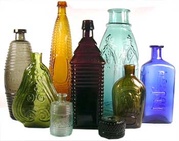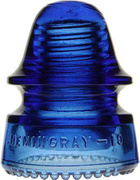Today’s guest blogger is antiques collector and dealer Marianne Dow, who writes about the bottle collecting hobby for the Findlay Antique Bottle Club. You can find her on Show & Tell, too.
At one of our Findlay Bottle Club meetings, Jeff passed around a fruit jar that was a smooth-lip Mason’s 1858, but in the familiar shade of aqua-ish blue of Ball fruit jars. It is conventional wisdom that all “Ball Blue”-colored jars were made by Ball (as no other fruit-jar maker has jars in this famous shade), so it stands to reason that this Mason’s 1858 was also made by Ball.
Why is only Ball glass that particular shade of blue? Jeff’s answer —”It’s all in the sand, baby!”
Most of us know glass is made from sand. You might not have known that glass color comes from the mineral content in the sand that’s used to make the glass. We wondered what was different about the sand that Ball used. How come no other company had sand that made their jars that particular shade? And why did Ball stop making jars in the signature color?
Turns out, the sand comes from an onetime Indiana landmark. According to the public library in Michigan City, Indiana:
“Once Indiana’s most famous landmark, Hoosier Slide was a huge sand dune bordering the west side of Trail Creek where it entered Lake Michigan. At one time it was nearly 200 feet tall, mantled with trees. Cow paths marked its slopes and people picnicked upon its crest. Climbing Hoosier Slide was very popular in the late 1800s with the excursionist crowds who arrived in town by boat and train from Chicago and other cities. The summit, where weddings were sometimes held, afforded an excellent view of the vast lumberyards which then covered the Washington Park area.
“With the development of Michigan City, the timber was cut for building construction and the sand began to blow, sometimes blanketing the main business district of the town on Front St., which nestled near its base.
“When it was discovered that the clean sands of Hoosier Slide were useful for glassmaking, the huge dune began to be mined away. Dock workers loaded the sand into railroad cars with shovel and wheelbarrow to be shipped to glassmakers [and other places].
“Over a period of 30 years, from about 1890 to 1920, 13 1/2 million tons of sand were shipped from Hoosier Slide until the great dune was leveled. By the 1920s, nothing remained of the giant dune.”
Here’s a telling excerpt from a memoir on emichigancity.com (the man is writing about his father):
“For twenty-five years, six days a week, he pushed an iron-wheeled wheelbarrow, moving sand from Hoosier Slide onto gondola carts headed for the manufacturing of canning jars.”
I don’t know exactly what geologic event caused the Hoosier Slide’s sand to have just the right mineral mix to create the famous Ball Blue glass color, but it was apparently something special that didn’t turn up in any other fruit jar maker’s glass.
Once the Hoosier Slide sand was all used up, Ball had to get another source, and the glass formula was forever changed. No more pretty Ball Blue. There are many shades of aqua and blue in the fruit jar world, but only the one Ball Blue.


 Bill Lindsey on How To Read a Bottle
Bill Lindsey on How To Read a Bottle
 Collecting Antique Ball Jars
Collecting Antique Ball Jars Bill Lindsey on How To Read a Bottle
Bill Lindsey on How To Read a Bottle Ian Macky Explains the Colors and History of Insulators
Ian Macky Explains the Colors and History of Insulators Fruit JarsThe evolution of fruit or canning jars parallels the science of food preser…
Fruit JarsThe evolution of fruit or canning jars parallels the science of food preser… Ball JarsThe roots of the Ball Glass Manufacturing Company go back to 1880, when Fra…
Ball JarsThe roots of the Ball Glass Manufacturing Company go back to 1880, when Fra… Mari Tepper: Laying it on the Line
Mari Tepper: Laying it on the Line Nice Ice: Valerie Hammond on the Genteel Charm of Vintage Canadian Costume Jewelry
Nice Ice: Valerie Hammond on the Genteel Charm of Vintage Canadian Costume Jewelry How Jim Heimann Got Crazy for California Architecture
How Jim Heimann Got Crazy for California Architecture Modernist Man: Jock Peters May Be the Most Influential Architect You've Never Heard Of
Modernist Man: Jock Peters May Be the Most Influential Architect You've Never Heard Of Meet Cute: Were Kokeshi Dolls the Models for Hello Kitty, Pokemon, and Be@rbrick?
Meet Cute: Were Kokeshi Dolls the Models for Hello Kitty, Pokemon, and Be@rbrick? When the King of Comedy Posters Set His Surreal Sights on the World of Rock 'n' Roll
When the King of Comedy Posters Set His Surreal Sights on the World of Rock 'n' Roll How One Artist Makes New Art From Old Coloring Books and Found Photos
How One Artist Makes New Art From Old Coloring Books and Found Photos Say Cheese! How Bad Photography Has Changed Our Definition of Good Pictures
Say Cheese! How Bad Photography Has Changed Our Definition of Good Pictures Middle Earthenware: One Family's Quest to Reclaim Its Place in British Pottery History
Middle Earthenware: One Family's Quest to Reclaim Its Place in British Pottery History Fancy Fowl: How an Evil Sea Captain and a Beloved Queen Made the World Crave KFC
Fancy Fowl: How an Evil Sea Captain and a Beloved Queen Made the World Crave KFC
Note: Here’s an excerpt from the Bottle Colors page on the phenominal Historic Glass Bottle Identification site — http://www.sha.org/bottle/colors.htm#Aqua
Aqua glass is a “natural” result of the iron impurities found in most sands. It is very rare (maybe unknown) that sand does not contain some traces of iron. Sand deposits with very low iron content were (and probably still are) highly valued commodities. Although good quality sand was plentiful in the Eastern United States, some was still being imported from Belgium for Western American glass factories as late as the 1940s. Aqua glass is the result of sand which is relatively low in the amount of iron which was not off-set by de-colorizing agents. High levels of iron produce darker greens, black glass, and even amber. Natural aqua glass was often called “green glass,” “bottle glass,” or “bottle glass green” by glass makers.
What is the value of a ball/mason jar before patent? i have a jar that says on it patent pending.
@Jan — This website should be able to help you:
http://balljarcollectorscommunitycenter.yuku.com/
I have a Ball Perfect Mason jar in aqua that comes in a wicker basket with two little handles. Someone gave me this jar and it’s been in my storage until today. Not seeing pictures of the jar in wicker. It has no top. Looks like the picture of jar next to 1858 jar. Found the comments most interesting that the blue color comes from the former dune in Indiana. Is it worth anything more with the basket?
Been told that blue Ball jar with 13 on the bottom rare. Is that so?? What is it worth??
Rare because of the superstition that 13 was a bad number to be canning by and they were broke. Do not know the price but have heard the same.
I have a tapered tall ball jar with a pat # of 105231 bottom of the jar has the numbers 9415 the other side it has a 9 on the bottom it has the indent showing it was hand blowen and the ball has the underscore, Ive not been able to find one like this , Id like to know is t value. thank you …. Ed
I suggest taking your BALL jar questions to this forum — the guys there know EVERYTHING about Ball jars, and are very friendly and helpful.
http://balljarcollectorscommunitycenter.yuku.com/
I READ SOME WHERE LONG AGO THAT BALL HAD PRODUCED A QT. JAR WITH THE EMBOSSING OF THE WORD PERFECT SPELLED (PEREECT). INSTEAD OF DESTROYING THEM THE BOTTOM OF THE SECOND “E” GROUND OFF TO LOOK LIKE A “F”. HAVE YOU HEARD OF THIS. I BELIEVE I HAVE ONE. WHAT OR HOW CAN THIS IMPERFECTION BE PROVEN,AND THE VALUE OF SUCH. THANK YOU.
Dear readers — please take all your Ball jar questions to the helpful Ball Jar Collectors Forum — http://balljarcollectorscommunitycenter.yuku.com/
Hi I just bought several boxes of ball and some kerr old mason jars from an estate sale that the woman owned a antique store many years ago. Some have glass tops with a wire attachment, some have a tin (?) screw on top but obviously very old. Where would I go to see what these are worth. Some are blue, aqua, and clear. I appreciaate any help you can give me.
What a great site! I have some of those beautiful Blue Ball Mason Jars that were made in MUNCIE, INDIANA, the birthplace of my Plummer father who’s mother was a Storer. Following grandmother’s burial my father and I made one last trip to the old Storer homeplace which was where I found my prized blue canning jars with lids. My quart jars are dated 1907 and 1909 while my pints are dated 1903 and 1907. No amount of money will ever buy these jars. Thanks for this site.
My father was the foreman at Hoosier Slide for 25 years.
His boss was: Willilam Manny, Hence: I am William Manny
Grandson of William Manny is still alive
Manny
I have this exact jar in this article it was made in nov. 30th 1858. How much is this jar worth? An on the bottom is the # 203 wondering how many were made if anyone knows?
Today, May 6, 2015, I again visited this site and continue to be awed at what Hoosier Slide meant to the community and how folks inquire about the antiquity of the mason jars the sand produced.
The 3 men pictured on the train tracks with Hoosier Slide in the background are: left, Dan Hutton, Train Master of the Monon Railroad” center, on tracks is Henry Dieckilman, Foreman ( working there for 25 plus years, on right, William Manny, owner of Hoosier Slide.
W. Manny Dieckilman
Thank you, W. Manny – I appreciate your telling us about your father. I updated the article on the Findlay Bottle Club website with info about you, your father, and your namesake. Here’s the link – http://finbotclub.blogspot.com/2015/05/hoosier-slide-jars.html
There is a theory now about the Hoosier Slide that relates to the little boy that was swallowed by a hole under the Mount Baldy sand dune and miraculously survived. It is believed by many that if the larger Hoosier slide had not been turned into canning jars, it would have blocked Mount Baldy and there would not have been the erosion that led to little Nathan’s fall into the hole and the need to close the Mount Baldy site to tourists. Mount Baldy was a huge tourist attraction and now no one can go there because of the treacherous holes under the dune.